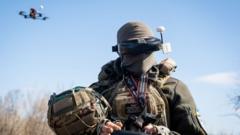The country is now calling on Western allies for financial support to expand its arms production capabilities amid a pressing need for advanced weaponry.
Ukraine's Bid for Self-Reliance in Arms Production Grows Stronger

Ukraine's Bid for Self-Reliance in Arms Production Grows Stronger
As the war against Russia intensifies, Ukraine shifts focus towards bolstering its domestic weapons manufacturing to ensure military sustainability.
In a factory located in central Ukraine, the sounds of machinery and labor resonate as the nation ramps up its arms production to meet the demands of an ongoing war with Russia. Ukrainian Armor, a private company, has recently doubled its output of armored personnel carriers and mortars, yet this production still falls short of Ukraine's needs in the conflict. CEO Vladislav Belbas acknowledges the inadequacy, stating, "We need to produce more.”
Ukraine is increasingly aware that it cannot depend primarily on Western allies for weapons due to inconsistent support and uncertainties surrounding U.S. assistance. Earlier in the conflict, Ukraine’s military relied heavily on artillery and small arms supplied by its partners. However, that reliance is shifting; today, Ukraine manufactures about 40 percent of the arms used on the front lines, with hopes for rapid expansion.
One area of notable growth has been the production of drones, which are now essential on the battlefield. President Volodymyr Zelensky has recognized this transformation, highlighting not only the charge to arm soldiers but also the psychological boost of self-sufficiency. "It does provide greater moral confidence that we will not be left empty-handed,” he stated regarding Ukraine's defense capabilities.
Despite the positive strides, funding remains a critical barrier. Experts indicate that Ukraine's defense industry possesses the infrastructure to produce $35 billion worth of military equipment annually, yet actual production pales at about $15 billion. With recent agreements yielding $500 million for arms manufacturing set to double, Ukraine still requires significant financial investment to align its production capacity with the battlefield demands.
The ever-evolving conflict puts additional strain on Ukraine's manufacturing ambitions. Russia's military budget exceeds $150 billion—a threefold advantage over Ukraine's finances—allowing it to outpace Ukraine's production rates. Ukrainian soldiers have underscored this disparity, indicating that Russian drones now dominate the skies, necessitating rapid innovation within their own defense industry.
Ukrainian Armor is adapting by developing vehicles designed to evade enemy detection while also embracing automation in warfare. Novel designs such as unmanned carriers demonstrate a push toward a tech-driven combat approach to enhance battlefield safety and efficiency. Nonetheless, traditional weaponry like mortars remains a cornerstone of their production efforts.
As Kyiv outlines plans for advanced weaponry production, collaborations with allies present new opportunities. By establishing weapons manufacturing facilities abroad with the backing of cooperative nations, Ukraine seeks to maintain defensive production capabilities beyond the reach of Russian strikes. Denmark has been the first to endorse this initiative, with hopes for additional partnerships.
In this landscape of ongoing war, President Zelensky has made a strong case for investment in Ukraine’s military sector, arguing that bolstering Ukraine’s defense capacity would ultimately serve the security interests of Europe as well. The path forward for Ukraine rests on a combination of increased domestic production and successful partnerships with Western allies to address the immediate challenges posed by the prolonged conflict with Russia.
Ukraine is increasingly aware that it cannot depend primarily on Western allies for weapons due to inconsistent support and uncertainties surrounding U.S. assistance. Earlier in the conflict, Ukraine’s military relied heavily on artillery and small arms supplied by its partners. However, that reliance is shifting; today, Ukraine manufactures about 40 percent of the arms used on the front lines, with hopes for rapid expansion.
One area of notable growth has been the production of drones, which are now essential on the battlefield. President Volodymyr Zelensky has recognized this transformation, highlighting not only the charge to arm soldiers but also the psychological boost of self-sufficiency. "It does provide greater moral confidence that we will not be left empty-handed,” he stated regarding Ukraine's defense capabilities.
Despite the positive strides, funding remains a critical barrier. Experts indicate that Ukraine's defense industry possesses the infrastructure to produce $35 billion worth of military equipment annually, yet actual production pales at about $15 billion. With recent agreements yielding $500 million for arms manufacturing set to double, Ukraine still requires significant financial investment to align its production capacity with the battlefield demands.
The ever-evolving conflict puts additional strain on Ukraine's manufacturing ambitions. Russia's military budget exceeds $150 billion—a threefold advantage over Ukraine's finances—allowing it to outpace Ukraine's production rates. Ukrainian soldiers have underscored this disparity, indicating that Russian drones now dominate the skies, necessitating rapid innovation within their own defense industry.
Ukrainian Armor is adapting by developing vehicles designed to evade enemy detection while also embracing automation in warfare. Novel designs such as unmanned carriers demonstrate a push toward a tech-driven combat approach to enhance battlefield safety and efficiency. Nonetheless, traditional weaponry like mortars remains a cornerstone of their production efforts.
As Kyiv outlines plans for advanced weaponry production, collaborations with allies present new opportunities. By establishing weapons manufacturing facilities abroad with the backing of cooperative nations, Ukraine seeks to maintain defensive production capabilities beyond the reach of Russian strikes. Denmark has been the first to endorse this initiative, with hopes for additional partnerships.
In this landscape of ongoing war, President Zelensky has made a strong case for investment in Ukraine’s military sector, arguing that bolstering Ukraine’s defense capacity would ultimately serve the security interests of Europe as well. The path forward for Ukraine rests on a combination of increased domestic production and successful partnerships with Western allies to address the immediate challenges posed by the prolonged conflict with Russia.





















